The Video Extensometer Market is estimated to be valued at USD 316.7 billion in 2025 and is projected to reach USD 525.7 billion by 2035, registering a compound annual growth rate (CAGR) of 5.2% over the forecast period.
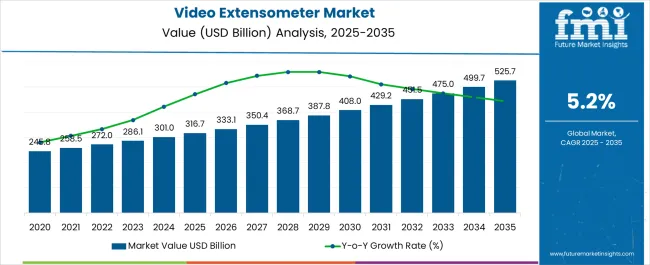
| Metric | Value |
|---|---|
| Video Extensometer Market Estimated Value in (2025 E) | USD 316.7 billion |
| Video Extensometer Market Forecast Value in (2035 F) | USD 525.7 billion |
| Forecast CAGR (2025 to 2035) | 5.2% |
The Video Extensometer market is witnessing steady growth driven by the increasing demand for precise, non-contact measurement solutions across diverse industries. The current market landscape reflects a shift from traditional mechanical extensometers to digital and camera-based systems that enable higher accuracy, faster data acquisition, and real-time analysis.
Growth is being influenced by rising automation in manufacturing, rigorous quality control standards, and the adoption of advanced materials that require more precise strain and displacement measurements. Industrial players are increasingly focusing on integrating video extensometers with data analytics platforms, which enhances process optimization and predictive maintenance.
Furthermore, the market outlook is being shaped by the expanding use of these systems in research and development labs, automotive testing, aerospace component validation, and materials characterization As organizations continue to invest in digital manufacturing technologies and smart testing solutions, video extensometers are expected to gain broader acceptance due to their flexibility, accuracy, and non-intrusive operation, supporting long-term market expansion.
The video extensometer market is segmented by sample type, end use, and geographic regions. By sample type, video extensometer market is divided into Metal, Ceramics, Plastics, Composites, Rubber, and Textiles. In terms of end use, video extensometer market is classified into Manufacturing, Mining, Clinical Research, Pharmaceutical, and BioPharmaceutical. Regionally, the video extensometer industry is classified into North America, Latin America, Western Europe, Eastern Europe, Balkan & Baltic Countries, Russia & Belarus, Central Asia, East Asia, South Asia & Pacific, and the Middle East & Africa.
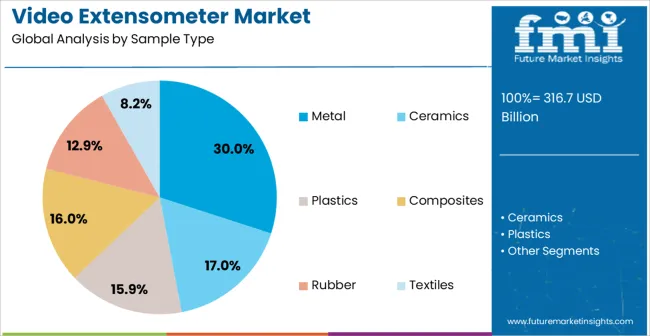
The metal sample type segment is projected to hold 30.00% of the Video Extensometer market revenue share in 2025, establishing it as the leading segment. This growth is being driven by the extensive use of metal components across manufacturing, automotive, aerospace, and construction industries where precision testing of tensile, compressive, and fatigue properties is critical. The adoption of video extensometers in this segment has been favored because they allow non-contact measurement, minimizing sample deformation and enabling repeatable, high-accuracy results.
Rising quality control standards and increasing research into advanced metal alloys have accelerated the deployment of camera-based measurement systems. Furthermore, integration with automated testing setups ensures consistent monitoring, real-time data logging, and efficient process control.
The durability and structural variability of metal specimens also necessitate flexible and adjustable measurement systems, further favoring video extensometer adoption As demand for high-performance materials grows, the metal sample type segment is expected to maintain its market leadership, driven by the need for precise and reliable measurement solutions.
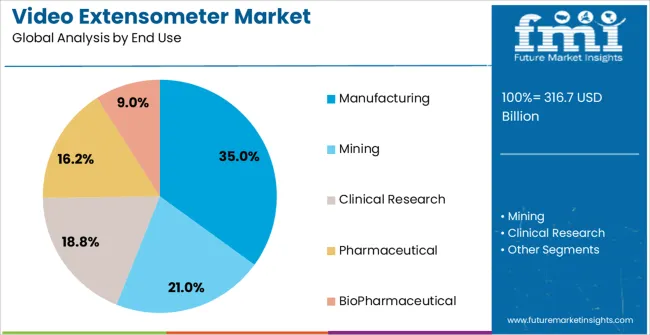
The manufacturing end-use industry segment is expected to account for 35.00% of the Video Extensometer market revenue in 2025, emerging as the largest consumer segment. This is being attributed to the increasing emphasis on production efficiency, quality assurance, and compliance with stringent industrial standards.
Video extensometers are being widely adopted in manufacturing environments due to their ability to provide accurate, non-contact measurement of strain, displacement, and deformation, which is critical for optimizing production processes and maintaining product reliability. The need for continuous process monitoring, coupled with the growing use of automated production lines, has further reinforced their adoption.
Additionally, the versatility of these systems allows them to measure a wide range of materials and geometries without altering the manufacturing setup, reducing downtime and improving operational efficiency As manufacturing facilities increasingly prioritize precision engineering, predictive maintenance, and digital process integration, the commercial deployment of video extensometers is expected to expand, sustaining the leadership of the manufacturing end-use segment in the market.
With recent developments and improvements in video technology and image analysis software, manufacturers are focused on video extensometers to provide precise measurement for a number of specific applications. The growing concerns of high precision and high accuracy during the test in various sectors across the world is generating the need for the video extensometer, which is efficiently driving the video extensometer market.
The demand for video extensometer is continuously growing in the manufacturing industries, clinical research, and the laboratories due to several benefits offered by the video extensometer such as no contact with sample, high resolution, and high accuracy.
There is a high need of the video extensometers for determination of physical properties of the high modulus samples such as composites, metals, high elongation materials, delicate or thin specimens, strained controlled testing, and crack opening in various laboratories and R&D. Due to this factor, the video extensometer market is expected to witness significant growth rates in the coming years.
Apart from this, there are various types of extensometer in the market, but as there are improvements in the computer software’s and the video technology, the new generation of video extensometer is widely used all over the globe is one of the significant factors which drives the growth of video extensometer market.
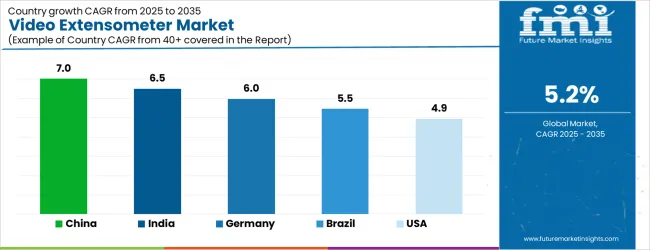
| Country | CAGR |
|---|---|
| China | 7.0% |
| India | 6.5% |
| Germany | 6.0% |
| Brazil | 5.5% |
| USA | 4.9% |
| UK | 4.4% |
| Japan | 3.9% |
The Video Extensometer Market is expected to register a CAGR of 5.2% during the forecast period, exhibiting varied country level momentum. China leads with the highest CAGR of 7.0%, followed by India at 6.5%. Developed markets such as Germany, France, and the UK continue to expand steadily, while the USA is likely to grow at consistent rates. Japan posts the lowest CAGR at 3.9%, yet still underscores a broadly positive trajectory for the global Video Extensometer Market. In 2024, Germany held a dominant revenue in the Western Europe market and is expected to grow with a CAGR of 6.0%. The USA Video Extensometer Market is estimated to be valued at USD 109.5 billion in 2025 and is anticipated to reach a valuation of USD 109.5 billion by 2035. Sales are projected to rise at a CAGR of 0.0% over the forecast period between 2025 and 2035. While Japan and South Korea markets are estimated to be valued at USD 15.1 billion and USD 11.1 billion respectively in 2025.
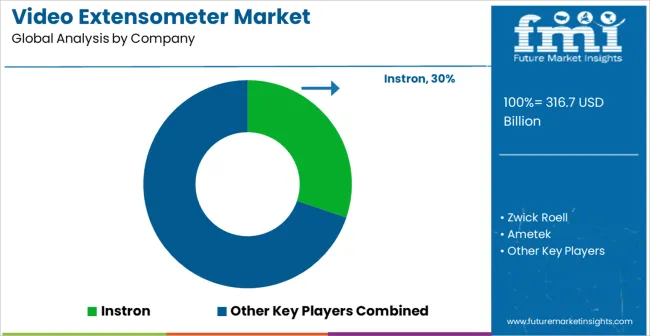
| Item | Value |
|---|---|
| Quantitative Units | USD 316.7 Billion |
| Sample Type | Metal, Ceramics, Plastics, Composites, Rubber, and Textiles |
| End Use | Manufacturing, Mining, Clinical Research, Pharmaceutical, and BioPharmaceutical |
| Regions Covered | North America, Europe, Asia-Pacific, Latin America, Middle East & Africa |
| Country Covered | United States, Canada, Germany, France, United Kingdom, China, Japan, India, Brazil, South Africa |
| Key Companies Profiled | Instron, Zwick Roell, Ametek, Shimadzu, MTS, Imetrum, Epsilon Tech, and BESMAK |
The global video extensometer market is estimated to be valued at USD 316.7 billion in 2025.
The market size for the video extensometer market is projected to reach USD 525.7 billion by 2035.
The video extensometer market is expected to grow at a 5.2% CAGR between 2025 and 2035.
The key product types in video extensometer market are metal, ceramics, plastics, composites, rubber and textiles.
In terms of end use, manufacturing segment to command 35.0% share in the video extensometer market in 2025.






Our Research Products

The "Full Research Suite" delivers actionable market intel, deep dives on markets or technologies, so clients act faster, cut risk, and unlock growth.

The Leaderboard benchmarks and ranks top vendors, classifying them as Established Leaders, Leading Challengers, or Disruptors & Challengers.

Locates where complements amplify value and substitutes erode it, forecasting net impact by horizon

We deliver granular, decision-grade intel: market sizing, 5-year forecasts, pricing, adoption, usage, revenue, and operational KPIs—plus competitor tracking, regulation, and value chains—across 60 countries broadly.

Spot the shifts before they hit your P&L. We track inflection points, adoption curves, pricing moves, and ecosystem plays to show where demand is heading, why it is changing, and what to do next across high-growth markets and disruptive tech

Real-time reads of user behavior. We track shifting priorities, perceptions of today’s and next-gen services, and provider experience, then pace how fast tech moves from trial to adoption, blending buyer, consumer, and channel inputs with social signals (#WhySwitch, #UX).

Partner with our analyst team to build a custom report designed around your business priorities. From analysing market trends to assessing competitors or crafting bespoke datasets, we tailor insights to your needs.
Supplier Intelligence
Discovery & Profiling
Capacity & Footprint
Performance & Risk
Compliance & Governance
Commercial Readiness
Who Supplies Whom
Scorecards & Shortlists
Playbooks & Docs
Category Intelligence
Definition & Scope
Demand & Use Cases
Cost Drivers
Market Structure
Supply Chain Map
Trade & Policy
Operating Norms
Deliverables
Buyer Intelligence
Account Basics
Spend & Scope
Procurement Model
Vendor Requirements
Terms & Policies
Entry Strategy
Pain Points & Triggers
Outputs
Pricing Analysis
Benchmarks
Trends
Should-Cost
Indexation
Landed Cost
Commercial Terms
Deliverables
Brand Analysis
Positioning & Value Prop
Share & Presence
Customer Evidence
Go-to-Market
Digital & Reputation
Compliance & Trust
KPIs & Gaps
Outputs
Full Research Suite comprises of:
Market outlook & trends analysis
Interviews & case studies
Strategic recommendations
Vendor profiles & capabilities analysis
5-year forecasts
8 regions and 60+ country-level data splits
Market segment data splits
12 months of continuous data updates
DELIVERED AS:
PDF EXCEL ONLINE
Video on Demand (VoD) Service Market Size and Share Forecast Outlook 2025 to 2035
Video Processing Platform Market Size and Share Forecast Outlook 2025 to 2035
Fluorescence Spectrophotometer Market Size and Share Forecast Outlook 2025 to 2035
Video Test Equipment Market Size and Share Forecast Outlook 2025 to 2035
Laboratory Grinders Market Size and Share Forecast Outlook 2025 to 2035
Automated Biochemical Analyzer Market Size and Share Forecast Outlook 2025 to 2035
Vapor Pressure Analyzer Market Size and Share Forecast Outlook 2025 to 2035
Ultrapycnometer Market Size and Share Forecast Outlook 2025 to 2035
Global PP Closure Market Size and Share Forecast Outlook 2025 to 2035
Video Game Market Size and Share Forecast Outlook 2025 to 2035
Video As A Sensor Market Size and Share Forecast Outlook 2025 to 2035
Global Positioning Systems Market Size and Share Forecast Outlook 2025 to 2035
Video Encoders Market Size and Share Forecast Outlook 2025 to 2035
Video Conferencing Market Size and Share Forecast Outlook 2025 to 2035
Global Glycidol Market Size and Share Forecast Outlook 2025 to 2035
Video Telematics Market Size and Share Forecast Outlook 2025 to 2035
Global Tert-Amylbenzene Market Size and Share Forecast Outlook 2025 to 2035
Global Sodium Hypochlorite Market Size and Share Forecast Outlook 2025 to 2035
Video Content Management Market Size and Share Forecast Outlook 2025 to 2035
Video Surveillance Storage Market Report - Growth & Demand 2025 to 2035

Thank you!
You will receive an email from our Business Development Manager. Please be sure to check your SPAM/JUNK folder too.
Chat With
MaRIA